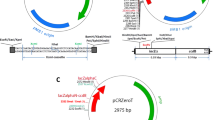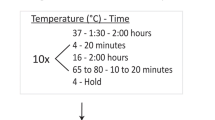Abstract
A 1330-bp DNA sequence with two XcmI cassettes was inserted into pUC18 to construct an efficient XcmI T-vector parent plasmid, pYEMF. The large size of the inserted DNA fragment improved T-vector cleavage efficiency, and guaranteed good separation of the molecular components after restriction digestion. The pYEMF-T-vector generated from parent plasmid pYEMF permits blue/white colony screening; cloning efficiency analysis showed that most white colonies (>75%) were putative transformants which carried the cloning product. The sequence analysis and design approach presented here will facilitate applications in the fields of molecular biology and genetic engineering.



Similar content being viewed by others
Abbreviations
- MCS:
-
Multi-cloning site
- IPTG:
-
β-d-1-Thiogalactopyranoside
- X-Gal:
-
5-Bromo-4-chloro-3-indolyl-β-d-galactopyranoside
- ORF:
-
Open reading frame
- US:
-
Upstream sites
- DS:
-
Downstream sites
References
Mychaleckyj, J. C. (2007). Genome mapping statistics and bioinformatics. Methods in Molecular Biology, 404, 461–488.
Tanaka, H. (2008). Bioinformatics and genomics for opening new perspective for personalized care. Studies in Health Technology and Informatics, 134, 47–58.
Ye, C. J., Gu, J. S., Chen, S., Deng, A. M., Li, Y. Z., & Li, D. X. (2010) Unit cloning and amplification as novel and universal strategies for complex vector construction and small DNA fragment preparation. Electrophoresis. Epub ahead of print.
Chen, S. B., Songkumarn, P., Liu, J. L., & Wang, G. L. (2009). A versatile zero background T-vector system for gene cloning and functional genomics. Plant Physiology, 150, 1111–1121.
Jun, S. Y., Yoon, S. J., & Kang, S. H. (2010). One-step preparation of a TA-cloning vector from a specially designed parent plasmid containing a dual lacZ gene system. Molecular Biotechnology, 45, 9–14.
Clark, J. M. (1988). Novel non-templated nucleotide addition reactions catalyzed by prokaryotic and eukaryotic DNA polymerases. Nucleic Acids Research, 16, 9677–9686.
Mead, D. A., Pey, N. K., Herrnstadt, C., Marcil, R. A., & Smith, L. M. (1991). A universal method for the direct cloning of PCR amplified nucleic acid. Biotechnology, 9, 657–663.
Kovalic, D., Kwak, J. H., & Weisblum, B. (1991). General method for direct cloning of DNA fragments generated by the polymerase chain reaction. Nucleic Acids Research, 18, 4560–4563.
Holton, T. A., & Graham, M. W. (1991). A simple and efficient method for direct cloning of PCR products using ddT-tailed vectors. Nucleic Acids Research, 18, 1156–1158.
Harrison, J., Molly, P. L., & Clark, S. J. (1994). Direct cloning of polymerase chain reaction products in an XcmI T-vector. Analytical Biochemistry, 216, 235–236.
Testori, A., & Sollitti, P. (1997). Cloning unmodified PCR products using engineered XcmI restriction sites in a portable cassette. Methods in Molecular Biology, 67, 89–100.
Arashi, N., Miwa, M., & Shibata, H. (1999). XcmI site-containing vector for direct cloning and in vitro transcription for PCR product. Molecular Biotechnology, 12, 281–283.
Borovkov, A. Y., & Rivkin, M. I. (1997). XcmI-containing vector for direct cloning of PCR products. BioTechniques, 22, 812–813.
De Vries, E. (1998). A vector for direct cloning of PCR products in a double XcmI restriction site offering compatible single 3′-overhanging T residues. Molecular Biotechnology, 10, 273–274.
Hu, X. J., Zhang, Z. C., Bao, Y. M., Yang, Q., & An, L. J. (2002). An expeditious method for constructing T-vectors using Eam1105I cassettes. Plant Molecular Biology Reporter, 20, 189a–189e.
Marchuck, D. M., Drum, A. S., & Collins, F. S. (1991). Construction of T-vectors, a rapid and general system for direct cloning of unmodified PCR products. Nucleic Acids Research, 19, 1154–1156.
Noureddine, H., & Gerald, A. B. (1996). Preparation of T-overhang vectors with high PCR product cloning efficiency. BioTechniques, 20, 20–22.
Acknowledgments
This study was supported by a General Program Grant from the National Natural Science Foundation of China (Grant No. 31070046), and the Science and Technology Research Grant Programs of University of Jinan (Grant Nos. B0301, B0524).
Author information
Authors and Affiliations
Corresponding author
Rights and permissions
About this article
Cite this article
Gu, J., Ye, C. pYEMF, a pUC18-Derived XcmI T-Vector for Efficient Cloning of PCR Products. Mol Biotechnol 47, 229–233 (2011). https://doi.org/10.1007/s12033-010-9333-y
Published:
Issue Date:
DOI: https://doi.org/10.1007/s12033-010-9333-y




